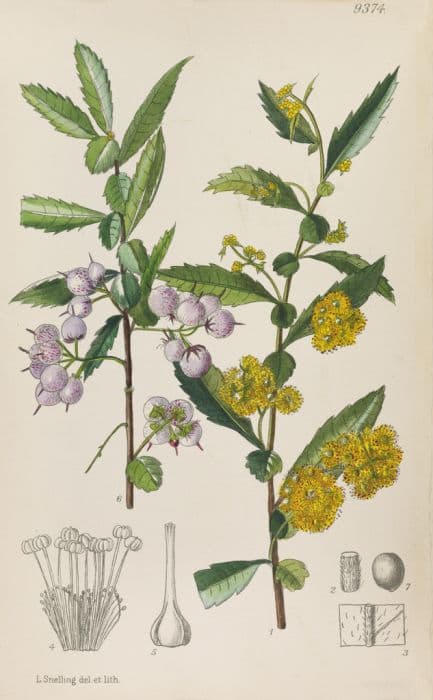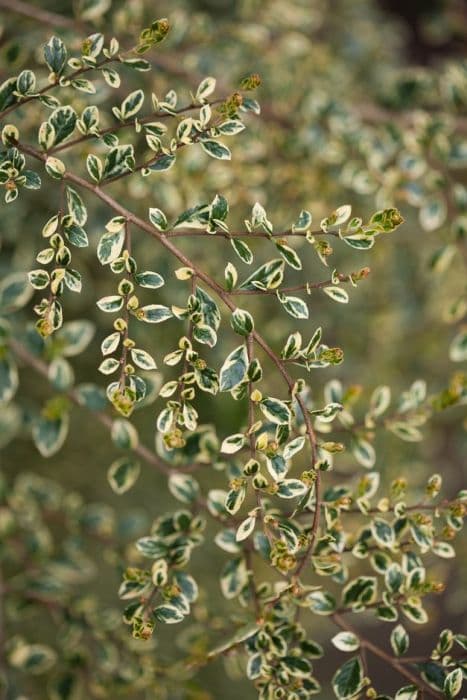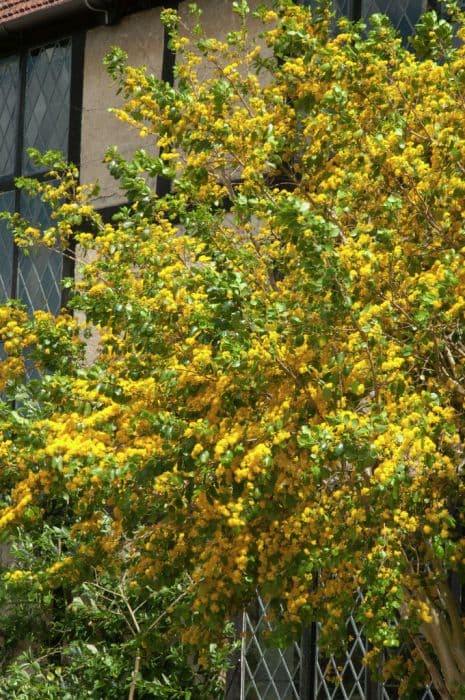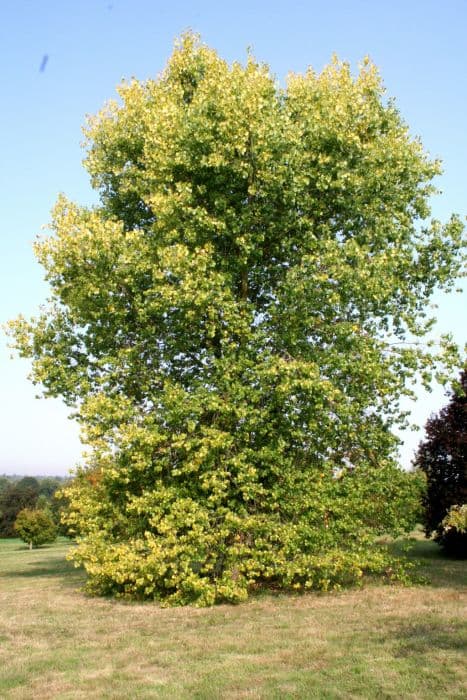False Nutmeg Carrierea calycina

ABOUT
Carrierea calycina, commonly referred to as Chinese nutmeg yew, exhibits a unique and striking appearance. Typically presenting as an evergreen tree, it showcases a broad and dense canopy which is adorned with glossy, leathery leaves. The foliage is deep green, and the leaves tend to be elongated with slightly curved edges, giving them a graceful look. This plant is particularly noted for its flowers and fruits. During its blooming period, it produces flowers that can range from subtle whites and creams to more pronounced yellows, which add a soft and delicate touch to the foliage. The male and female flowers grow on separate trees, with the male flowers arranged in clusters and the female flowers sitting alone, looking somewhat inconspicuous. Once pollinated, the female plants give rise to oblong fruits whose appearance is somewhat reminiscent of a small plum. These fruits transition through colors as they mature, starting with a green tint and eventually turning into a deep, bluish-black shade when ripe, which contrasts starkly with the green foliage, creating a visual spectacle. The flesh of the fruit encases a hard seed that has likened it to the nutmeg, hence the common name. Overall, the Chinese nutmeg yew has a lush, sturdy appearance, with its solid growth habit and richly colored parts contributing to its ornamental allure. It can captivate the attention in varied settings, be it a formal garden landscape or a natural woodland area, with its year-round verdant presence and seasonal cycles of flowering and fruiting.
About this plant
 Names
NamesSynonyms
False Nutmeg.
Common names
Idesia polycarpa, Carrierea latifolia, Clompanus calycina, Clompanus latifolia, Samyda calycina.
 Toxicity
ToxicityTo humans
There is limited information readily available on the toxicity of Carrierea calycina, which is commonly known as Chinese Glorybower, to humans. Therefore, it is advisable to exercise caution and consider it potentially harmful until more definitive information is available. If it is poisonous, symptoms could range from mild to severe and may include gastrointestinal distress, vomiting, diarrhea, or more serious symptoms depending on the level of toxicity. Always keep unknown plants out of reach of children and consult a medical professional or poison control center if ingestion occurs.
To pets
The toxicity of Chinese Glorybower, or Carrierea calycina, to pets such as dogs and cats is not well-documented in widely accessible literature. As a precaution, pet owners should assume that it could be harmful and prevent pets from ingesting this plant. If the plant is indeed poisonous, pets may exhibit symptoms such as vomiting, diarrhea, drooling, lethargy, or more serious signs of poisoning. If you suspect your pet has ingested any part of this plant, contact a veterinarian or an animal poison control service immediately.
 Characteristics
CharacteristicsLife cycle
Perennials
Foliage type
Deciduous
Color of leaves
Green
Flower color
White
Height
20-30 feet (6-9 meters)
Spread
15-20 feet (4.6-6 meters)
Plant type
Tree
Hardiness zones
7
Native area
China
Benefits
 General Benefits
General Benefits- Ecosystem Support – Carrierea calycina provides habitat and food for a variety of wildlife, such as insects and birds, thus contributing to biodiversity.
- Ornamental Value – The plant is often used in gardens and landscapes for its aesthetic appeal, with its distinctive flowers and structure enhancing the visual environment.
- Shade Provider – When grown as a tree, Carrierea calycina can offer shade in gardens and parks, creating cooler areas for leisure activities.
- Soil Improvement – As a natural part of ecosystems, this plant can help to maintain soil quality and prevent erosion through its root system.
- Cultural Significance – In areas where Carrierea calycina is indigenous, it may have cultural importance and be used in traditional practices or ceremonies.
 Medical Properties
Medical PropertiesThis plant is not used for medical purposes.
 Air-purifying Qualities
Air-purifying QualitiesThis plant is not specifically known for air purifying qualities.
 Other Uses
Other Uses- Carrierea calycina, commonly known as the Chinese royal fern, has been utilized in artistic arrangements due to its aesthetically pleasing flowers and foliage.
- The wood of the Chinese royal fern is sometimes used in the creation of small ornamental objects, as it is hard and has a fine grain.
- The tree is occasionally planted as a living fence in rural landscapes, providing a natural boundary that is both beautiful and functional.
- In traditional cultures, the leaves of the Chinese royal fern might have been used for thatching small shelters or huts.
- The seed pods are sometimes incorporated into decorative crafts and jewelry because of their unique shape and texture.
- Chinese royal ferns can be used in educational settings for botanical studies due to their distinct morphological characteristics, aiding in the teaching of plant life cycles and reproduction.
- The tree's bark could be used in tanning or dyeing processes as a source of tannins or pigments, although specific documentation on traditional uses may be limited.
- The fragrant flowers of the Chinese royal fern can be used in the production of natural perfumes or scented sachets for aromatic purposes.
- Its branches and twigs may serve as natural tools for gardening, such as stakes or supports for climbing plants.
- Culturally, the tree may have significance in certain communities, where it can be associated with local folklore or used in ceremonial plantings.
Interesting Facts
 Feng Shui
Feng ShuiThe Chinese coffin tree is not used in Feng Shui practice.
 Zodiac Sign Compitability
Zodiac Sign CompitabilityThe Chinese coffin tree is not used in astrology practice.
 Plant Symbolism
Plant Symbolism- Resilience: Carrierea calycina, also known as Chinese False Anemone, has a strong and sturdy nature, symbolizing the ability to withstand adverse conditions and bounce back with vigor.
- Purity: The clean, white flowers of the Chinese False Anemone may represent purity and innocence, evoking a sense of calm and serenity.
- Beauty: With its elegant blossoms, the plant is often associated with beauty and the appreciation of aesthetic pleasures.
- Rareness: As it's not as commonly known as other plants, the Chinese False Anemone can symbolize uniqueness and the value of rarity.
- Growth: Its lifecycle and development from bud to bloom can be seen as a metaphor for personal growth and development.
 Water
WaterThe Chinese Fountain Brush, which is the common name for Carrierea calycina, requires consistent moisture but does not like to be waterlogged. It's best to water this plant when the top inch of the soil feels dry, which typically equates to watering once or twice a week depending on environmental conditions. Provide about 1 gallon of water per watering session to ensure deep soil saturation. During winter months, reduce the frequency as the plant's water requirements decrease. Always check the soil moisture level before watering to avoid overwatering which can lead to root rot.
 Light
LightThe Chinese Fountain Brush thrives best in partial shade to full sun. The ideal spot would be where the plant receives morning sunshine and is protected from the intense heat of the afternoon sun. Bright, indirect light will help to encourage the growth of healthy leaves and flowers. Do not place this plant in deep shade, as it can hinder its growth and flowering potential.
 Temperature
TemperatureThe Chinese Fountain Brush prefers moderate temperatures and can tolerate a range from around 40 degrees Fahrenheit to 95 degrees Fahrenheit. The ideal temperature for optimal growth is between 60 and 80 degrees Fahrenheit. Avoid exposing the plant to temperatures below 40 degrees Fahrenheit, as frost can severely damage or kill it.
 Pruning
PruningPruning the Chinese Fountain Brush is mainly done to shape the plant and encourage bushier growth. The best time for pruning is early spring, just before the growth season begins. Cut back any dead or damaged branches, and trim the plant to maintain its desired shape. It is not necessary to prune this plant frequently; once per year is often sufficient.
 Cleaning
CleaningAs needed
 Soil
SoilChinese Fairy Bells thrive in well-draining, fertile soil, rich in organic matter with a slightly acidic to neutral pH of 6.0 to 7.0. A recommended soil mix includes compost or peat, loam, and perlite or sand to aid drainage.
 Repotting
RepottingChinese Fairy Bells should be repotted every 2-3 years to ensure they have enough room for root growth and to refresh the soil, which should remain fertile and well-draining.
 Humidity & Misting
Humidity & MistingChinese Fairy Bells prefer moderate to high humidity levels, with ideal conditions around 50-60% for optimal growth, although they can tolerate slightly lower levels with proper care.
 Suitable locations
Suitable locationsIndoor
For indoor growth, ensure bright, indirect light and moderate humidity.
Outdoor
Plant in partial shade, protect from strong winds and frost.
Hardiness zone
7-9 USDA
 Life cycle
Life cycleCarrierea calycina, also known as the Chinese Fringetree, starts its life as a seed, which after dispersal, typically requires a period of dormancy before germination, influenced by environmental factors such as temperature and moisture. Upon germination, the seedling emerges and establishes itself, developing roots and a shoot system, and relying on stored seed energy before it can photosynthesize. The sapling stage follows, characterized by rapid growth as the plant develops a more robust root system and increased foliage for energy capture through photosynthesis. Once mature, the Chinese Fringetree produces fragrant white flowers during the spring, which are pollinated by insects, leading to the production of fruits that mature in the fall, containing seeds for the next generation. After reaching reproductive maturity, the plant enters a period of maintenance where the focus is on annual flowering and seed production, leading to natural seed dispersal. The Chinese Fringetree can live for several decades, and eventually, the plant senesces and dies, completing its life cycle.
 Propogation
PropogationPropogation time
Spring to Summer
Carrierea calycina, commonly known as Chinese coffin tree, is typically propagated using seeds. The most popular way to propagate this plant begins with collecting ripe seeds from beneath the parent tree. Sow the seeds in a well-draining seed starting mix, ensuring they are lightly covered with soil. This process is ideally carried out in the spring to allow the full growing season for the seedlings to develop. Seeds usually require stratification, a period of cold treatment, to break dormancy and improve germination rates. After stratification, seeds are placed in a warm environment to germinate; this can take several weeks to a few months. Once seedlings emerge and grow strong enough, they can be carefully transplanted to individual pots or directly to their desired location in the garden.









